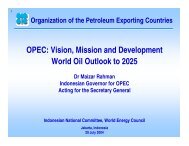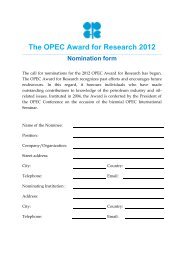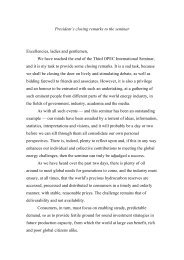Section One
Section One
Section One
Create successful ePaper yourself
Turn your PDF publications into a flip-book with our unique Google optimized e-Paper software.
high priority agenda for OPEC Member Countries. It is also the main objective of<br />
the assistance they provide to other developing countries, directly through their own<br />
aid institutions, as well as through the OPEC Fund for International Development<br />
(OFID). In total, they have provided close to $350 billion (in 2007 prices) in development<br />
assistance to other developing countries in the period 1973–2010. This amounts<br />
to nearly $10 billion a year. 56 A significant portion of this amount, $69 billion, has<br />
been devoted to energy related projects, covering a diverse portfolio of energy sources<br />
that includes financial support to renewable energy sources. OFID particularly targets<br />
least developing countries and assists in the pursuit of sustainable social and economic<br />
advancement. Today, 129 countries from the developing world have benefited from<br />
OFID assistance.<br />
Human resources<br />
The human resource plays a strategically important role in the oil and gas business.<br />
The ability to innovate, explore, plan, and execute large-scale, complex development<br />
projects in a cost effective and environmentally-friendly manner requires a highly<br />
qualified and experienced work force. However, the future availability of qualified<br />
technical talent remains a major challenge facing the oil industry.<br />
The Great Recession has had a significant impact in terms of job losses and a lack<br />
of job creation in the industry. However, the origins of this talent shortfall lie back<br />
in the 1980s and 1990s. It was then that the oil and gas industry saw a wave of cost<br />
cutting and redundancies. The result of this was that many technical people who were<br />
then entering their mid-career left the industry for good. Moreover, it was as this time<br />
that many universities cut back drastically on the number of student places for energy<br />
disciplines because the industry was not deemed to need graduates in such numbers.<br />
In recent years, there has also been fierce competition for talent, particularly from<br />
the service and emerging knowledge economies. And in addition, there is a sizeable<br />
section of the industry’s workforce, particularly the large numbers that entered the<br />
industry in the 1970s, that are now approaching retirement.<br />
It is clear, however, that the industry will need more qualified people in the<br />
years ahead. It begs the question: how can the industry find, hire, train and keep<br />
talented people?<br />
It is evident from the history of the oil industry that there have been periods that<br />
could be characterized ‘boom’ and others that could be viewed as ‘bust’. In periods of<br />
growth, companies have traditionally boosted their capital expenditure and recruited<br />
more staff. And when the industry has struggled somewhat, the situation has normally<br />
been reversed. It is important, however, that the industry finds new approaches and<br />
143<br />
Chapter<br />
4
















